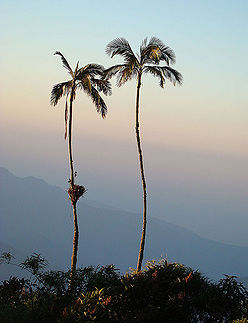Ceroxylon vogelianum
| Ceroxylon (seh-ROKS-ih-lon) vogelianum (voh-jeh-lee-AHN-uhm) | |||||||
|---|---|---|---|---|---|---|---|
 Marta Mountains of northeastern Colombia. Photo by Dick Culbert. | |||||||
| Scientific Classification | |||||||
| |||||||
| Synonyms | |||||||
|
| |||||||
| Native Continent | |||||||
|
| |||||||
| Morphology | |||||||
| |||||||
| Culture | |||||||
|
| |||||||
| Survivability index | |||||||
|
| |||||||
| Common names | |||||||
|
| |||||||
Contents
Habitat and Distribution
Ceroxylon vogelianum is found in Colombia, Ecuador, Peru, and Venezuela. Ceroxylon vogelianum is widely distributed through the Andes from Venezuela to Colombia, Ecuador, and Peru, in humid montane forest, at (1900-) 2200-2900 m. Although it is one of the most common palms of the high tropical Andes, it never forms extense stands, and is commonly sparse on mountain ridges. (Maria Jose Sanin and Gloria Galeano. 2011)/Palmweb.Contrary to some sources, this species is not found in Bolivia.
Description
Stem 3-13 (-17) m tall, 12-25 cm in diameter, rarely flexuous toward the apex, green to silverish, covered with a very thin layer of wax. Leaves 6-18 in the crown, in a very variable but always untidy, hemispheric crown; sheath (32-) 50-90 (-130) cm long, 2.5 cm wide; petiole (15-) 24-75 cm long, 2-5 cm wide at apex, adaxially glabrescent with remnant of scales, abaxially with brown-grayish indumentum, sometimes almost glabrescent; rachis (38-) 77-140 (-210) cm long, adaxially flattened in basal ½ of its lenght that end in a small almost unconspicuous hastula-like projection,
| read more |
|---|
|
glabrescent, abaxial surface convex, covered with scales degraded into flexuous threads, and persistent 0.2-0.6 mm elliptical bases, arranged in adjacent, 0.2-0.3 mm wide rows; pinnae 46-80 (-129) on each side of rachis, arranged in groups of 2-10 pinnae, separated by 2.0-6.5 (-12.0) cm, and inserted in divergent planes, specially towards the base and the middle of the leaf, adaxial surface glabrescent, abaxial surface and midrib covered with elliptical to linear, very thin and narrow, translucent, cream scales, the basal, filiform pinnae 8.5-50 × 0.2-0.5 mm, basal pinnae (10th from base) 20-58 (-89) × 0.7-2.2 cm, middle pinnae 23-75 (-95) × (1.1-) 2.2-3.5 (-4.5) cm, apical pinnae 11-37 × 0.1-0.8 cm, not connate along margins. Staminate inflorescences 5-7 at one time, peduncle 125 cm long, 2.5 cm wide at apex; prophyll 26 cm; peduncular bracts at least 6, 54-106 × 5-8 cm, with an additional smaller, 7 cm bract inserted at the apex of the peduncle; rachis 34.5 cm long, with about 40 branches, each subtended by a 0.5-3.0 cm long, thin and narrow, membranaceous, acuminate bract, rachis and branches glabrescent, longest branches near base, 15.5-33.0 cm long. Pistillate inflorescences 1-5 at one time; peduncle 77-150 (-248) cm long, 2.0-4.0 cm wide at apex; prophyll 17-45 cm long; peduncular bracts 5-7, 25-187 × 4-13 cm; rachis (22-) 52-62 (-100) cm long, with about 31-53 branches, each subtended by a 0.2-1.5 cm membranous bract, longest branches in basal half, (12-) 20-51 cm long; prophyll, peduncle, bracts and base of rachis covered with persistent, brown to ferrugineous, intermixed fibres of interlocked scales with minute round, 0.1 mm bases, arranged in troughs formed in between veins, rachillae glabrous. Staminate flowers: sepals 3, elliptical-long acuminate, 0.8-1.5 mm long, connate for 0.2 mm (1/4-1/7 of total length), reaching or almost reaching the total length of corolla tube; petals 3, elliptical-long acuminate like sepals, 4.5-5.5 mm long, connate in 1.0-1.5 mm, acumen 1.5-2.5 mm long; stamens 6, alternating 1 antisepalous, and 1 antipetalous stamen, filaments 1.0-1.5 mm long, inserted at basal 2/5 to central portion of anther, anthers 1.6-2.5 mm long, anther connective not projected; pistillode trifid, minute. Pistillate flowers: sepals 3, broadly-triangular, narrowly acuminate, 1.0-1.5 mm long, connate for 0.4-0.7 mm (½ of total length), not reaching corolla tube, petals 3, elliptical, very narrowly acuminate to subulate, 5-6 mm long, connate for up to 1.0-2.0 mm, acumen narrow, 1.5-2.0 mm long; staminodes 6, 1 antisepalous, 1 antipetalous, filaments 1.5 mm long, broad at base, then narrowing at tip, abortive anthers 0.9-1.2 mm long, pistil green, trifid, 2-3 mm in diam. Fruits globose, orange-red when ripe, 1.6-2.0 cm in diam., exocarp reticulate sulcate, furrowed; perianth persistent, sepals in a swollen coriaceous ring around pedicel, 0.8-1.5 mm high, not reaching total height of the corolla tube, petals elliptical-acuminate, 3-6 cm long, including a 1-2 mm acumen, connate in 1.0-1.5 mm, staminodes with very thick filaments that are broadened at base, and with no remaining abortive anthers at this point. Seeds 1.1-1.6 cm in diam. (Maria Jose Sanin and Gloria Galeano. 2011)/Palmweb. Editing by edric. Plants from S Ecuador, where the species is common, are relatively small, compared to what is usual for the species. (Borchsenius, F. 1998)/Palmweb. Ceroxylon vogelianum is, together with C. parvifrons, the most frequent and widely distributed species of Ceroxylon. It is unmistakable by its small size, with slender, usually greenish or brownish stem, leaves ascending, with pinnae arranged in groups and inserted in very divergent planes, staminate flowers with 6 stamens on slender filaments, and fruits with the very characteristic reticulate sulcate exocarp. The specimens from Bolivia that had been determined as C. vogelianum actually correspond to C. pityrophyllum (see comments under this species), therefore C. vogelianum is not found in this country, although several texts report it. (Maria Jose Sanin and Gloria Galeano. 2011)/Palmweb. |
Culture
Cold Hardiness Zone: 8b
Comments and Curiosities
| read more |
|---|
|
Conservation: In Venezuela, C. vogelianum has been recorded as Endangered (EN) according to the IUCN criteria, mainly due to deforestation practices along the Andes (Llamosas et al. 2003). In Colombia the species was only considered Near Threatened (NT; reproductive biology of this species, as it is expected to be endangered due to the deforestation process due to agricultural Galeano et al. 2005) because of its wide distribution, but more studies need to be done related to the population dynamics and activity in the Andes of Colombia. (Maria Jose Sanin and Gloria Galeano. 2011)/Palmweb. Uses: The new leaves are cut for Palm Sunday during Easter, and the stems are used to build fences and houses. Ceroxylon vogelianum (coco), a solitary palm with grey trunk is found between 2000 and 3000 m. The small green fruits (1.5 cm diameter)are edible and the leaves are used for thatching. (Maria Jose Sanin and Gloria Galeano. 2011)/Palmweb. "This is one of the least impressive wax palms of South America. It is a relatively short, thin-trunked species with barely any waxy coating on the trunk. The trunk is ornamentally ringed and bright green with a thin layer of white wax over it, but nothing like the monsters in this genus. The leaves are mostly flat but have a bit of 'plumoseness' to them (leaflets on different planes coming off the rachis). I have seen many local palm experts grow this palm only to have it croak inexplicably without a moments notice. It has a pretty narrow margin of climatic happiness, liking it cool, but not cold, and never baking hot and humid. There is a relatively large one growing in the Huntington Gardens, Pasadena, California with about 12' of trunk and is the only one in So Cal I have seen attain any decent trunk height before dying. This one always looks like this will be its last year... but I said that 4 years ago and it's still growing. Easy to germinate the seed... it's just then that things get difficult." (Geoff Stein) "The only place you can grow this palm in the US is probbaly San Francisco and the rest of the foggy areas of the bay." (Kyle Wicomb) |
This is a tillering palm, it exhibits saxophone style root growth (it has a heel), keep top third of heel above soil elevation!
- IMAGE GALLERY
External Links
- Glossary of Palm Terms
- MODERN BOTANICAL LATIN
- "Just To Be Clear"
- http://www.scielo.org.pe/scielo.php?pid=S1727-99332008000000007&script=sci_arttext
- http://www.palmtalk.org/forum/index.php?/topic/56853-ceroxylon-vogelianum/
- THE SAXOPHONE STYLE ROOT GROWTH (HEEL)
References
Phonetic spelling of Latin names by edric.
Special thanks to Geoff Stein, (Palmbob) for his hundreds of photos.
Special thanks to Palmweb.org, Dr. John Dransfield, Dr. Bill Baker & team, for their volumes of information and photos.
Glossary of Palm Terms; Based on the glossary in Dransfield, J., N.W. Uhl, C.B. Asmussen-Lange, W.J. Baker, M.M. Harley & C.E. Lewis. 2008. Genera Palmarum - Evolution and Classification of the Palms. Royal Botanic Gardens, Kew. All images copyright of the artists and photographers (see images for credits).
Borchsenius, F.1998. Manual to the palms of Ecuador. AAU Reports 37. Department of Systematic Botany, University of Aarhus, Denmark in collaboration with Pontificia Universidad Catalica del Ecuador.
Sanin, Maria Jose & Galeano, Gloria. 2011. A revision of the Andean wax palms, Ceroxylon (Arecaceae).
Many Special Thanks to Ed Vaile for his long hours of tireless editing and numerous contributions.





































